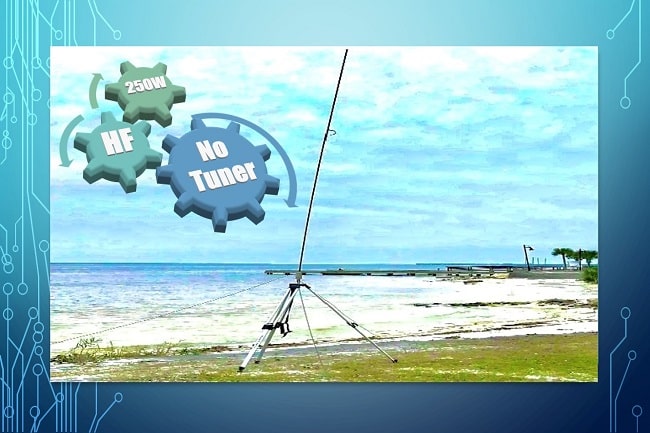The Alpha Vertical Antenna is a tripod-mounted 13-foot whip that uses an “Alpha Match” at the base of the whip to achieve broadband matching from 40m to 6m. Setup of the Alpha vertical is virtually effortless, involving opening up the tripod, screwing on and extending the whip, and connecting the Alpha Match. I measured the frequency response of the antenna with my MFJ analyzer and confirmed the published data of an SWR of 2:1 or less over the stated band. I used a coax feedline of about 20 feet, the minimum length recommended by Alpha, inasmuch as the coax shield and tripod work together to form a counterpoise.
Peeking inside the Alpha Match, one finds a ferrite transformer configuration that transforms the antenna impedance and, also, introduces loss to achieve low SWR over 7 – 54 MHz. It is worthwhile to note that with the “difficult” impedance presented by the 12-foot whip over this frequency range, the only way to achieve a good broadband match is to introduce loss into the matching network. This is a consequence of the “gain-bandwidth theorem” which states the fundamental laws of nature relating load impedance, matching networks, and SWR bandwidth. Having consulted extensively for industry on matching network design, I can say that trading-off loss for extended antenna bandwidth is a standard technique that has been used extensively, particularly in military applications with “electrically-small” antennas.
The Alpha website recommends that a minimum of 20 Watts be used to drive the antenna, in recognition of the loss through the Alpha Match. Steve D., the owner of Alpha, told me in e-mail correspondence that the ratio of effective radiated power to the power applied to the antenna (ERP/Pin) is 50% for Pin of 20 Watts, rising to 90% for a Pin of 100 Watts. At a Pin of 10 Watts, the ratio was only 25%, hence the recommendation to avoid QRP power levels with the Alpha Match. However, it should be noted that Alpha also manufactures their “Alpha DX Antenna”, which, employing a high-Q tuning system, does indeed allow efficient operation from QRP power levels up to 1 kW.
I performed the following experiment at 7 MHz. I compared the performance of the Alpha antenna to a base-loaded 12-foot vertical placed on the Alpha tripod. With the base-loaded antenna, I connected a single 33-foot counterpoise elevated about 5 feet off the ground. I adjusted the loading coil and counterpoise length to give a very good match at 7 MHz. The Alpha performed two S-units below the base-loaded vertical in on-air (CW) comparisons in both transmit and receive. This is typical of the compromise one must accept with a broadband match of a shortened vertical antenna versus a single-frequency match. Although I did not perform any further experiments, one may expect the relative performance of the Alpha to improve as you move up in frequency.
Other vertical antennas that appear to offer the same kind of broadband capability cost close to twice the price of the Alpha Vertical.
The Alpha. is a great choice for those applications where broadband operation is required with absolutely no tuning adjustments being necessary. The construction is first rate, the setup is elegant simplicity, the price is reasonable, and the performance is very good for an antenna of this type.
AB2EW
-
 MIL EmComm Deluxe FMJ$519.00Rated 4.98 out of 5 based on 100 customer ratings
MIL EmComm Deluxe FMJ$519.00Rated 4.98 out of 5 based on 100 customer ratings

